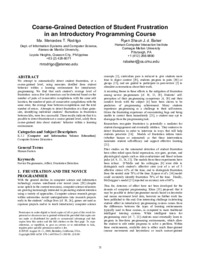Coarse-grained detection of student frustration in an introductory programming courseMa. Mercedes T. Rodrigo, Ryan Shaun Joazeiro de Baker
Publikationsdatum:
Zu finden in: ICER 2009 (Seite 75 bis 80), 2009
|
 |
 Diese Seite wurde seit 1 Jahr inhaltlich nicht mehr aktualisiert.
Unter Umständen ist sie nicht mehr aktuell.
Diese Seite wurde seit 1 Jahr inhaltlich nicht mehr aktualisiert.
Unter Umständen ist sie nicht mehr aktuell.
 Zusammenfassungen
Zusammenfassungen
We attempt to automatically detect student frustration, at a coarse-grained level, using measures distilled from student behavior within a learning environment for introductory programming. We find that each student's average level of frustration across five lab exercises can be detected based on the number of pairs of consecutive compilations with the same edit location, the number of pairs of consecutive compilations with the same error, the average time between compilations and the total number of errors. Attempts to detect frustration at a finer grain-size, identifying individual students' fluctuations in frustration between labs, were less successful. These results indicate that it is possible to detect frustration at a coarse-grained level, solely from coarse-grained data about students' behavior within a learning environment.
 Dieses Konferenz-Paper erwähnt ...
Dieses Konferenz-Paper erwähnt ...
 Begriffe KB IB clear |  Programmieren Programmieren programming programming
|
 Zitationsgraph
Zitationsgraph
 Zitationsgraph (Beta-Test mit vis.js)
Zitationsgraph (Beta-Test mit vis.js)
 2 Erwähnungen
2 Erwähnungen 
- ICER 2019 - Proceedings of the 2019 ACM Conference on International Computing Education Research, ICER 2019, Toronto, ON, Canada, August 12-14, 2019 (Robert McCartney, Andrew Petersen, Anthony V. Robins, Adon Moskal) (2019)
- Computing Education Theories - What Are They and How Are They Used? (Lauri Malmi, Judy Sheard, Päivi Kinnunen, Simon, Jane Sinclair) (2019)


- Computing Education Theories - What Are They and How Are They Used? (Lauri Malmi, Judy Sheard, Päivi Kinnunen, Simon, Jane Sinclair) (2019)
- DELFI 2024 (Sandra Schulz, Natalie Kiesler) (2024)


- Correlation of Error Metrics in Python CS1 Courses (Annabell Brocker, Ulrik Schroeder) (2024)


- Correlation of Error Metrics in Python CS1 Courses (Annabell Brocker, Ulrik Schroeder) (2024)
 Anderswo finden
Anderswo finden
 Volltext dieses Dokuments
Volltext dieses Dokuments
 |  Coarse-grained detection of student frustration in an introductory programming course: Fulltext at the ACM Digital Library ( Coarse-grained detection of student frustration in an introductory programming course: Fulltext at the ACM Digital Library ( : :  , 443 kByte; , 443 kByte;  : :  Link unterbrochen? Letzte Überprüfung: 2020-11-28 Letzte erfolgreiche Überprüfung: 2020-08-11) Link unterbrochen? Letzte Überprüfung: 2020-11-28 Letzte erfolgreiche Überprüfung: 2020-08-11) |
 Anderswo suchen
Anderswo suchen 
 Beat und dieses Konferenz-Paper
Beat und dieses Konferenz-Paper
Beat hat Dieses Konferenz-Paper während seiner Zeit am Institut für Medien und Schule (IMS) ins Biblionetz aufgenommen. Beat besitzt kein physisches, aber ein digitales Exemplar. Eine digitale Version ist auf dem Internet verfügbar (s.o.). Aufgrund der wenigen Einträge im Biblionetz scheint er es nicht wirklich gelesen zu haben. Es gibt bisher auch nur wenige Objekte im Biblionetz, die dieses Werk zitieren.










 Biblionetz-History
Biblionetz-History